Keyboard Tester
Updated: 15/02/2024
438

Have you ever found yourself typing away and suddenly… boom!
A key gets stuck, weird symbols appear, or you swear you didn’t press a button! Annoying, right?
Don’t worry, we’ve all been there. That’s where our super helpful online keyboard tester comes in!
It’s like a magic mirror for your keyboard, showing you exactly what’s happening. Is the keyboard key not working? Stuck keys? Ghost clicks? No problem!
This excellent tool helps you fix things fast and efficiently so you can get back to typing smoothly and without any worries. Think of it as your typing superhero, saving you from keyboard meltdowns!
Understanding the Purpose of Our Online Keyboard Tester
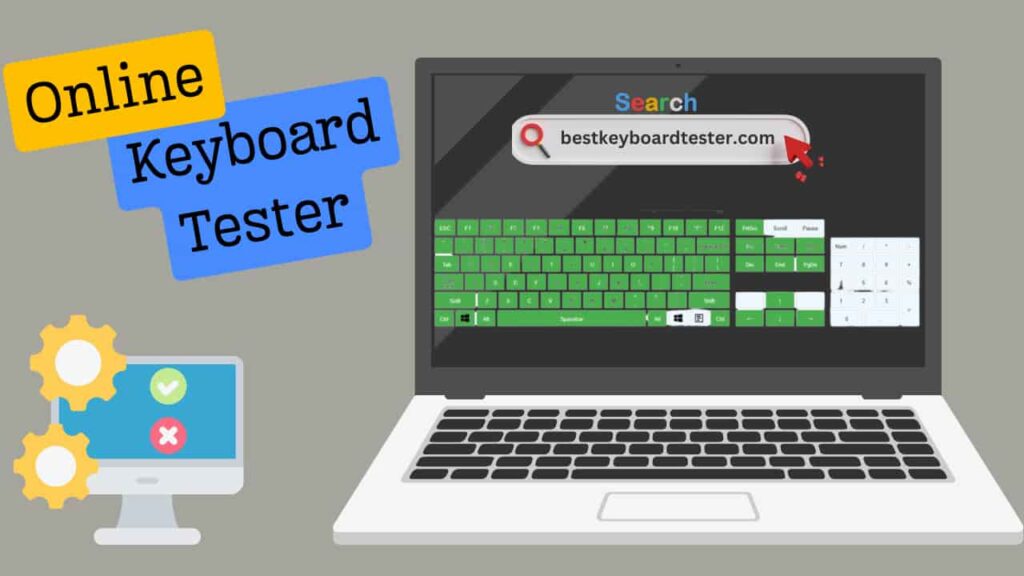
Our online keyboard tester is designed to help you identify any faulty keys on your keyboard instantly and efficiently. This user-friendly tool helps diagnose keyboard issues to prevent more problems. It is easy to use and can quickly identify any problem. Fixing issues early can prevent major problems.
By testing your keyboard regularly, you can ensure the keyboard’s overall performance and improve typing efficiency.
Our Keyboard Tester online tool is compatible with all keyboards, including gaming, laptop, and wireless. It can effectively test all keys, providing peace of mind and saving you the hassle of dealing with keyboard problems.
Now, let’s explore who can benefit from our keyboarding key test.
Who Can Benefit from Our Keyboard Key Tester?
Our online Keyboard Testing tool is designed to be accessible and user-friendly for many users. Whether you’re a gamer, a student, a professional, or simply someone who relies on their keyboard daily, or People who experience typing issues, this tool has something to offer:
- Gamers: Gamers often require high-performing gaming keyboards for an optimal gaming experience. Our keyboard test online can help them ensure their keyboards function at their best. Test the keyboard for any sticky keys or responsiveness issues before they impact your gameplay.
- Students and Writers: Perfect your essays, assignments, or creative writing. A functional pc keyboard is essential for efficient typing. Our tool can examine if every key on your keyboard is working right. This helps you avoid problems when you’re writing something important. Also, if you have an online typing test coming up, our tool can help you practice and get better at typing fast and accurately. This way, you can feel sure when you take your typing test exam.
- Hardware Managers: Testing multiple keyboards for hardware maintenance in offices or schools can be time-consuming. Our keyboard checker online simplifies the process, making identifying faulty keys easier.
- Individuals with Keyboard Issues: If you think a key on your keyboard is not working properly, we can help you verify its status. If a key doesn’t light up on our virtual keyboard when pressed, it indicates a problem with that key.
- Anyone with a Keyboard: We test your laptop, desktop, or wireless keyboard to ensure they function properly. This helps you feel sure they will run smoothly when needed and make it easy for you to type.
Remember that our service is 100% free, doesn’t require registration, and offers light mode for your convenience. So go ahead and test your keyboard—it’s just a few key presses away!
Why Use Our Keyboard Tester?
Our keyboard tester is a powerful online tool designed to help you assess the functionality of your keyboard. Here are some key reasons why you should use our keyboard keys tester:
1. Accuracy:
Our virtual keyboard tester is designed to provide precise and reliable results by simulating key presses. Verify if the keys on your physical keyboard are working correctly.
2. Multi-Key Testing:
Try pressing multiple keys simultaneously. Your device is in good shape if it registers correctly on the virtual keyboard. This feature helps identify any issues with simultaneous key presses.
3. Compatibility:
Our keyboard key testing is compatible with all keyboards, ensuring you can quickly test any keyboard. Whether you have a basic Windows keyboard, a Mac Mini keyboard, a full Mac keyboard, an external keyboard, or even a USB keyboard, our tester can handle them all. Our tool can provide accurate results regardless of your keyboard’s layout or design.
4. Convenience:
Unlike other testing methods that require downloading software or plugins, our mechanical keyboard tester is entirely browser-based. No matter if you use Chrome, Firefox, Safari, or any other popular web browser, our tool will work well. It will let you easily diagnose if your keyboard buttons are working properly.
You can use it on any device that’s connected to the internet. This makes it easy and convenient for keyboard key testing.
5. Privacy:
We understand the importance of data being kept secret. Our keyboard tester does not store any typing history or personal information. Your keyboard test remains confidential, ensuring your privacy is protected.
6. Free to Use:
Our online keyboard tester is free for everyone. You can use it anywhere and and at any moment. There is no cost to test your keyboard keys. In the past, people paid for this service, but not anymore!
Don’t worry about keyboard problems on your laptop; our laptop keyboard switch tester ensures all keys work perfectly.
How to Use the Keyboard Tester? Step-by-Step Guide
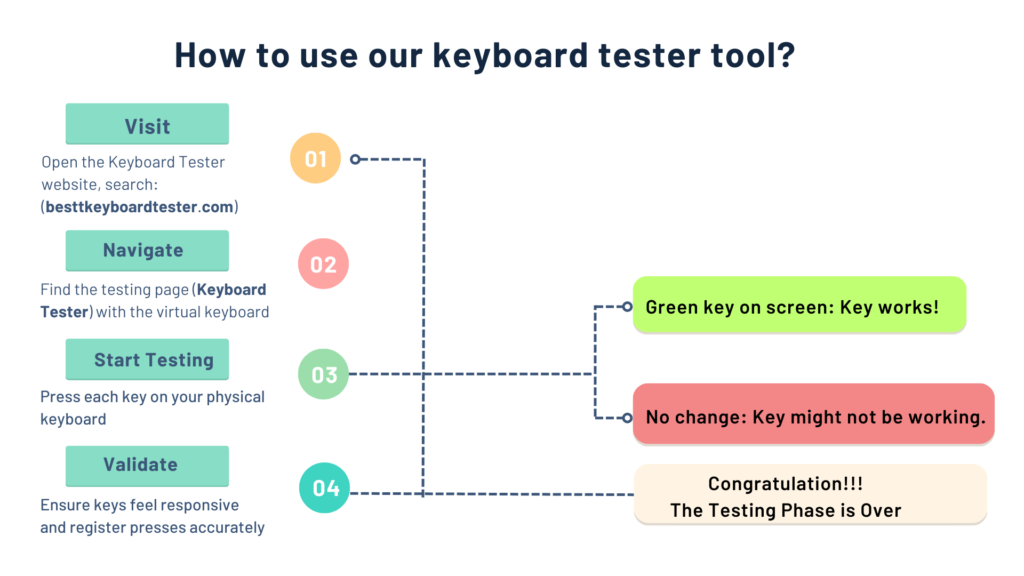
Now that you understand the benefits of our keyboard tester tool, let’s explore how to use it. Testing your keyboard keys is simple, ensuring a seamless testing experience. It involves three key steps: Opening the keyboard tester tool, pressing any key to test, and validating your press.
Following these steps, you can quickly test all the keys on your keyboard and identify any potential keyboard issues. Let’s dive into the details of each step.
1. Open the Keyboard Tester Website:
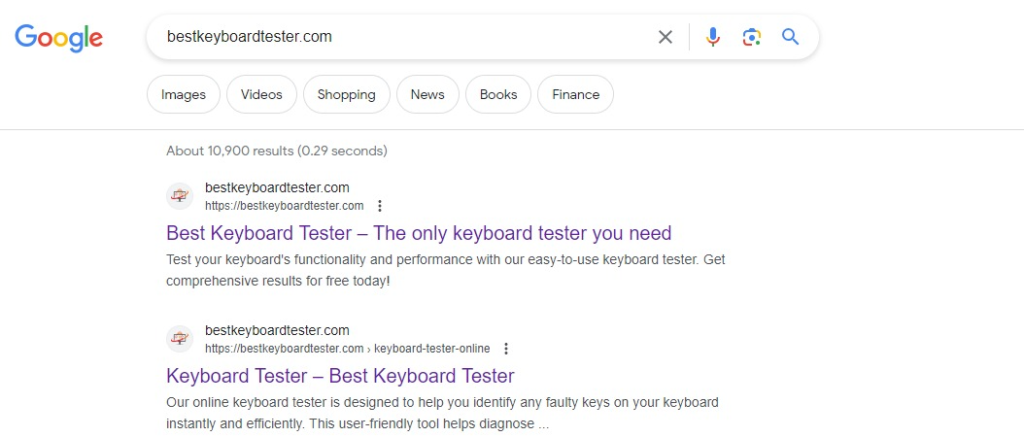
Begin by visiting the Keyboard Tester website on your device. You can do this by searching for “bestkeyboardtester.com” in your preferred search engine.
2. Navigate to the Testing Page:
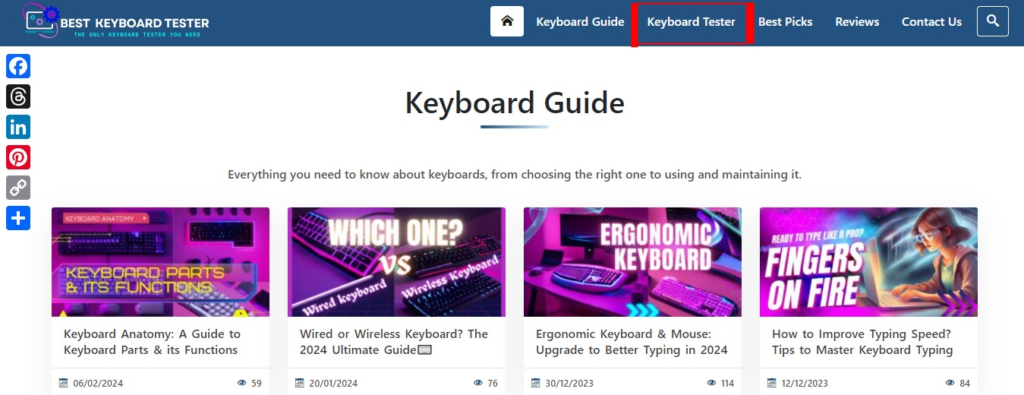
Once on the website, navigate to the testing page (Keyboard Tester) specifically designed for keyboard testing. The virtual keyboard will be displayed on your screen, mirroring your physical keyboard layout.
Ensure it appears correctly and covers all the keys you want to test. If you scroll down and the screen does not show the virtual keyboard, you can’t check the keys on your keyboard. Once you have accessed the keyboard tester tool, you are ready to move on to the next step of the testing process.
3. Press Any Key To Test:

Once the keyboard tester tool is open, start testing by pressing each key on the keyboard. To make sure your keyboard is working correctly, please follow these steps:
- Begin by pressing each key on your keyboard one by one, i.e., starting with the letter “A.”
- After pressing a key, verify if the corresponding key on the keyboard above turns green (or light green if you hold the key). If the virtual keyboard’s key turns green, that key is working correctly.
- Continue this process for every key on your keyboard. Test alphabet keys, function keys (like F1, F2, etc.), special keys (Enter, Shift, and Caps Lock), and numeric keys.
- By the end of the online keyboard test, all the keys should have turned green.
If the color is not green, then it means that the key you pressed is not working on your physical keyboard. This is how easy it is to test keys online.
4. Validate Your Press:

- After testing all keys, take a moment to validate your experience.
- Ensure that each key feels responsive and registers your presses accurately.
- Pay attention to any keys that may feel sticky or unresponsive or produce unexpected results.
- Consider cleaning the keyboard or seeking professional assistance if you encounter any issues.
Common Keyboard Issues Detected by Our Tool
Even the best keyboards can have problems after being used for a while. It’s essential to know about these problems and how to fix them. Our tool can find many keyboard issues, like ghosting, keyboard keys not working, and key rollover. When you know about these problems, you can do the right things to keep your keyboard working well.
Let’s look at some of these common keyboard issues in more detail.
1. Ghosting:
Ghosting occurs when you press multiple keys at the same time, but the keyboard fails to register all of them. This issue is common in older or low-quality keyboards.
- To reduce ghosting:
- Invest in a keyboard with anti-ghosting technology. These keyboards can handle simultaneous key presses without issues.
- If you’re experiencing ghosting, try pressing fewer keys at once or use a different combination.
2. Key Revolver:
Key revolver refers to keys getting stuck or repeating unintentionally after being pressed.
- Solutions:
- Clean your keyboard: Dust and waste can cause keys to stick. Use compressed air or a soft brush to clean between the keys.
- Identify for physical damage: Inspect the keys for any visible damage. If a keycap is loose or broken, consider replacing it.
- Update drivers: Ensure your keyboard drivers are up to date. Visit the manufacturer’s website for the latest drivers.
3. Keys Not Working:
When specific keys stop functioning, it can disrupt your typing experience.
- Restart your computer: Mostly, a simple reboot resolves keyboard issues.
- Connections issues: If your wired computer keyboard suddenly stops working, check the connection to your computer. Unplug it and plug it back in. For wireless keyboards, ensure they have sufficient battery life or connect them to a power source.
- Try disabling and re-enabling Bluetooth (for wireless keyboards) or switching between Bluetooth and 2.4GHz wireless.
- Unplug all other accessories except the keyboard and reboot your computer.
- Run a virus to Evaluate and rule out malware interference.
4. Function Keys Not Working:
If your Function (Fn) key is not working as expected, there are several potential reasons and solutions to consider:
1. Check the Mode of Operation:
- Some laptops allow you to lock the Fn key, which affects how the function keys (F1-F12) behave.
- Certain key combinations won’t work as expected if you’ve accidentally locked the Fn key.
- To unlock the Fn key, try the following key combinations based on your laptop brand:
- Dell/Lenovo: Press Fn + Esc
- HP: Press Fn + Shift or Ctrl + Fn
- Asus: Press Fn + Esc, Fn + Insert, or Fn + Shift
- Alternatively, you can access the BIOS settings and change the Hotkey Mode or Function Key Behavior to ensure the Fn key performs as intended.
2. Driver Issues:
- Outdated or faulty keyboard drivers can cause malfunctioning keys, including the function keys.
- Solution: Update your keyboard driver through your device manager. Here’s how:
- Windows: Right-click the Start menu, select “Device Manager,” expand “Keyboards,” right-click on your keyboard, and choose “Update driver.”
- Mac: Go to “System Preferences,” then “Keyboard,” and click the “Update Keyboard Firmware” button (if available).
3. Check for Software Settings:
- Verify that your keyboard settings in Windows are correct.
- Make sure you haven’t accidentally remapped keys or changed language settings.
- Access the BIOS to see if the laptop recognizes the keyboard hardware.
4. Inspect the Hardware:
- If none of the above steps help, consider hardware-related issues.
- Unplug your laptop and remove the battery.
- Check for a keyboard icon under the battery seating area; if present, you can remove the keyboard by unscrewing it.
- If not, you may need to remove the entire base of the laptop to access the keyboard.
Remember to follow safety precautions when working with hardware components. If unsure, consult your laptop’s manual or seek professional assistance. Hopefully, one of these steps will help you get your Function key working again!
Troubleshoot Common Keyboard Issues
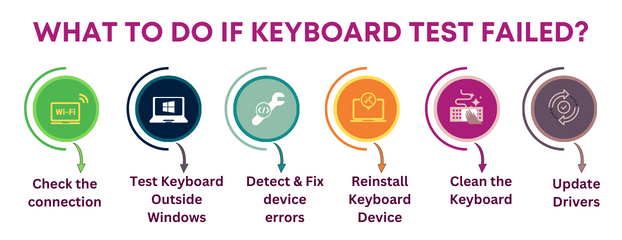
If you’re experiencing keyboard issues, here are some troubleshooting steps you can try:
- Check Physical Connections:
- For wired keyboards, ensure they are securely connected to your computer.
- For wireless keyboards, check battery life and ensure it’s turned on.
- Restart Your Computer:
- Sometimes, a simple restart can resolve temporary issues.
- Test Keyboard Outside Windows:
- Restart your computer and check if the keyboard works before logging into Windows.
- Start the PC in Safe Mode to rule out software conflicts if it works.
- Run the Windows Keyboard Troubleshooter:
- Go to Settings > Update & Security > Troubleshoot.
- Look for the Keyboard under Find, fix other problems, and run the troubleshooter.
- Check NumLock and Function Keys:
- Ensure NumLock is disabled (especially for laptops).
- Press the appropriate function key (like F12 or Esc) to enter the CMOS setup.
- Clean the Keyboard:
- Turn off your laptop or unplug the keyboard.
- Gently shake the keyboard upside down to remove debris.
- Use compressed air to blow out crumbs from underneath the keys.
- Wipe sticky keys with a cotton swab and rubbing alcohol.
Remember to keep your original keyboard driver for backup, and consider consulting a technician if hardware issues persist. Hopefully, these steps will help you restore your keyboard to working order!
Tips for Maintaining Your Keyboard’s Performance
If you want your keyboard to keep working great for years to come, here are some things you can do to take care of it.
Keep it Clean
- Why: To make sure your Keyboard works well for a long period.
- How: Clean it often to remove dust, crumbs, and dirt between the keys. You can use compressed air or a soft brush to clean it.
Avoid Liquids
- Why: To stop liquids from damaging your Keyboard.
- How: Don’t put drinks near your Keyboard. If a spill happens, unplug the Keyboard and clean it right away.
Protect from Dust
- Why: To keep dust from causing problems.
- How: Use a dust cover or a protective case when you’re not using the Keyboard. This stops dust from getting on the keys.
Use Keyboard Shortcuts
- Why: To save time and reduce wear on the keys.
- How: Learn and use keyboard shortcuts instead of pressing the keys too much.
Conclusion:
In conclusion, keyboard testing is essential for maintaining your Keyboard’s functionality and longevity. Utilizing an online keyboard tester can quickly diagnose and troubleshoot any issues, ensuring that all keys respond accurately. Our online keyboard tester provides precise detection, compatibility with various keyboards, and seamless browser support. Regular testing with our tool and following maintenance tips ensure optimal keyboard performance for a smooth computing experience.
Test your Keyboard now with our online keyboard tester and ensure all your keys function optimally! Don’t let faulty keys delay your productivity.
If you have any other keyboard-related questions, feel free to ask!
How do I test my Keyboard?
You can quickly test your Keyboard using our online keyboard tester. Open the tester. Press any key on your physical Keyboard, and the corresponding Key on the virtual one will light up green, indicating functionality. If they match, your Keyboard is working well. Make sure all keys are functioning correctly.
Why should I Use the Laptop Keyboard tester?
A laptop keyboard tester helps you:
- Verify that your laptop keyboard is working properly.
- Identify any malfunctioning keys.
- Save time and effort by diagnosing issues online.
What keyboard layouts is this test designed for?
Our keyboard tester is designed to resemble a general English keyboard or American keyboard layout, but it’s not an exact match. While it works with any layout, the buttons on your physical Keyboard may be in different spots. It supports desktop and laptop keyboards, ensuring compatibility with different keyboard designs.
Don’t worry! The virtual keys will light up when you press them, no matter where they are located physically. So go ahead and test those keys – if the entire virtual Keyboard lights up, your Keyboard has passed the test!
Why choose online keyboard test?
Online keyboard testers offer several advantages:
- It’s free, quick, and convenient.
- No need to download software or visit a repair shop.
- Instantly check if your keyboard is functioning as expected.
Why is my Function Key Not Working?
Function keys (F1 to F12) serve various purposes. If they’re not working:
- Check function lock: Some keyboards have a function lock key (usually labeled “Fn”). Make sure it’s not activated.
- Enable function keys: Some laptops turn off function keys by default. You can generally toggle this in BIOS settings.
- Update drivers: As always, keep your drivers up to date.
Remember, a quick reboot often works wonders, and keeping your keyboard clean is essential.
What to do if the Key Tester Fails?
Suppose the key tester fails to provide accurate results, or you suspect it is not working correctly. In that case, you can take several troubleshooting steps. First, test the keyboard on another device to ensure the issue differs from the computer or device you are currently using.
Check for any physical damage or debris obstructing the keys, as these can interfere with the tester’s functionality. Consider using a compressed air cleaner to remove dust or particles affecting the tester’s performance. If the tester continues to fail, it may be necessary to contact the manufacturer for further assistance.
When Should You Use a Keyboard Tester?
Here are some situations where you might want to test your keyboard:
- Experiencing typing issues: Missed keystrokes, wrong characters, or unresponsive keys.
- Getting a new keyboard: Checking functionality before relying on it for daily tasks.
- Regular maintenance: Occasionally testing your keyboard helps identify issues early on.
Who Should Use the Key Tester?
The key tester benefits many individuals, including gamers, programmers, typists, and professionals who rely heavily on their keyboards.
Gamers can use the key tester to test the responsiveness of gaming keys, ensuring an optimal gaming experience. Programmers can benefit from the key tester by testing the layout and functionality of specific keys required for coding. Typists can use the key tester to verify the performance of individual keys, ensuring accurate typing. Professionals, such as writers, content creators, and office workers, should also use the key tester to validate the keyboard’s functionality.
How Can I Resolve Laptop Keyboard Problems?
Tips for Resolving Laptop Keyboard Issues:
- Check for spills: Liquid damage can lead to keyboard malfunction. If your laptop has been exposed to liquid, seek professional help immediately.
- Disable sticky keys: This feature can cause delays in registering keystrokes. Go to your system’s accessibility settings to check.
- Clean the keyboard: Dust and debris can accumulate under the keys, causing issues. Use compressed air or a soft brush to clean.
By following these tips and utilizing available tools, you can effectively test and maintain your keyboard, ensuring a smooth and efficient typing experience.